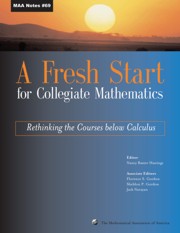Book contents
- Frontmatter
- Preface
- Contents
- Introduction
- Background
- Theme 1 New Visions for Introductory Collegiate Mathematics
- Theme 2 The Transition from High School to College
- Theme 3 The Needs of Other Disciplines
- Theme 4 Student Learning and Research
- Theme 5 Implementation
- Theme 6 Influencing the Mathematics Community
- Ideas and Projects that Work: Part 1
- Ideas and Projects that Work: Part 2
- 35 Mathematics in Action: Empowering Students with Introductory and Intermediate College Mathematics
- 36 Precalculus: Concepts in Context
- 37 Rethinking College Algebra
- 38 From The Bottom Up
- 39 The Functioning in the Real World Project
- 40 The Importance of a Story Line: Functions as Models of Change
- 41 Using a Guided-Inquiry Approach to Enhance Student Learning in Precalculus
- 42 Maricopa Mathematics
- 43 College Algebra/Quantitative Reasoning at the University of Massachusetts, Boston
- 44 Developmental Algebra: The First Mathematics Course for Many College Students
- 45 Workshop Precalculus: Functions, Data, and Models
- 46 Contemporary College Algebra
- 47 Precalculus: A Study of Functions and Their Applications,
- 48 Success and Failures of a Precalculus Reform Project
40 - The Importance of a Story Line: Functions as Models of Change
from Ideas and Projects that Work: Part 2
- Frontmatter
- Preface
- Contents
- Introduction
- Background
- Theme 1 New Visions for Introductory Collegiate Mathematics
- Theme 2 The Transition from High School to College
- Theme 3 The Needs of Other Disciplines
- Theme 4 Student Learning and Research
- Theme 5 Implementation
- Theme 6 Influencing the Mathematics Community
- Ideas and Projects that Work: Part 1
- Ideas and Projects that Work: Part 2
- 35 Mathematics in Action: Empowering Students with Introductory and Intermediate College Mathematics
- 36 Precalculus: Concepts in Context
- 37 Rethinking College Algebra
- 38 From The Bottom Up
- 39 The Functioning in the Real World Project
- 40 The Importance of a Story Line: Functions as Models of Change
- 41 Using a Guided-Inquiry Approach to Enhance Student Learning in Precalculus
- 42 Maricopa Mathematics
- 43 College Algebra/Quantitative Reasoning at the University of Massachusetts, Boston
- 44 Developmental Algebra: The First Mathematics Course for Many College Students
- 45 Workshop Precalculus: Functions, Data, and Models
- 46 Contemporary College Algebra
- 47 Precalculus: A Study of Functions and Their Applications,
- 48 Success and Failures of a Precalculus Reform Project
Summary
If students are to remember what they learn, the courses they take must tell a coherent story. This story provides a framework onto which they can hang their newly acquired knowledge. Without such a framework, teachers find themselves having to repeat material. Precalculus courses often run the risk of not being memorable because they are defined as the skills needed in calculus rather than telling a coherent story. Thus, the first decision in designing a new precalculus course is to choose the story it will tell.
The central theme we chose for our precalculus course is how functions can be used to model change. This theme provides a framework into which all the prerequisite material for calculus naturally fit (functions, graphing, algebra, trigonometry, numerical approximation), while at the same time illuminating a central concept of calculus—the rate of change [1]. Choosing a family of functions to represent a real situation requires students to think about the qualitative behavior of different types of functions. A good way to decide, for example, whether an exponential function fits a particular set of data is to look at a plot. The shape of the plot suggests the family; the values of the parameters are then determined from the data.
We have found that introducing the rate of change as the slope of a line is an excellent springboard for comparing the behavior of linear and exponential functions (absolute versus relative rate of change), and for introducing the concepts of increasing, decreasing, and concavity.
- Type
- Chapter
- Information
- A Fresh Start for Collegiate MathematicsRethinking the Courses below Calculus, pp. 352 - 354Publisher: Mathematical Association of AmericaPrint publication year: 2006

